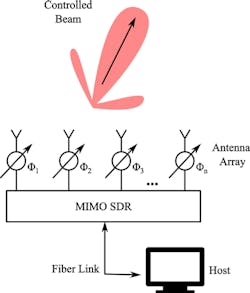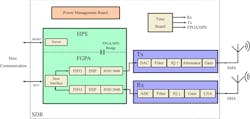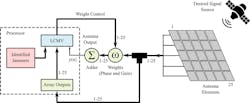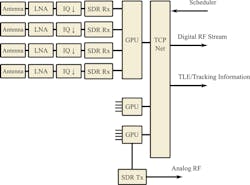Strengthen SATCOM with SDR-Enhanced Phased-Array Antennas
This article is part of the TechXchange: Antenna Design
Members can download this article in PDF format.
What you’ll learn:
- The operation of ground stations and phased-array antennas.
- How SDRs are integrated into ground stations.
- Issues to be considered when incorporating SDRs into phased-array antennas.
- Examples of research being conducted on electronically steerable antennas.
Satellite communication (SATCOM) is one of the pillars of the modern world, with applications including Global Positioning System (GPS) and Global Navigation Satellite System (GNSS) navigation, space research, telecommunications, internet access, weather monitoring, and law-enforcement surveillance.
Together with the satellite itself, ground stations are crucial to the SATCOM industry. They transmit and receive data to and from the satellite, process the information, and apply it to different purposes, depending on the application. Therefore, it’s fundamental to ensure an efficient, reliable, and robust communication link between satellites and ground stations, which can prove to be difficult with conventional antennas.
Phased-array technologies are designed to overcome these issues, providing a more controlled and focused electromagnetic link by taking advantage of destructive and constructive interference. They can be electronically steered to point in different directions without physically moving the antennas. However, phased arrays require integration with high-performance software-defined radios (SDRs) to operate properly.
The conventional way of focusing the electromagnetic beam consists of mechanical machinery moving reflector antennas to one satellite working at one frequency, which is often too simplistic for complex SATCOM systems. This is especially the case in constellations, where data from multiple satellites are required simultaneously.
Novel beamforming techniques implemented with phased-array antennas and SDRs are becoming increasingly popular. When compared to large reflectors, they offer lower cost, less maintenance, higher flexibility and modularity levels, and more efficient use of the electromagnetic spectrum. Furthermore, SDR-based ground stations can simultaneously track several satellites working at different frequencies and modulation schemes, and in turn, significantly reduce the requisite number of ground stations.
This article discusses the basic principles of ground stations, the advantages of newer phased-array antennas for SATCOM, their main challenges, and the solutions that SDR-based systems provide to these applications.
Ground Stations
Ground stations (GSs) are land facilities or installations that communicate with spacecraft using radio frequencies, serving as the mediator between the Earth application and deployed satellite. The term also encompasses the reception of electromagnetic waves from astronomical sources, but in this article, we will focus on satellite applications.
The communication between the GS and the satellite is typically performed using super-high-frequency (SHF) and extremely-high-frequency (EHF) bands, including microwaves, via parabolic antennas. The general radio structure of legacy GSs consists of a parabolic reflector, a feedhorn, a waveguide, and an RF transceiver, which is where SDRs are implemented. Some systems also may use a radome sphere to protect and hide the radio components.
The parabolic dish reflects all electromagnetic waves coming from the satellite to a single confocal point, where the feedhorn antenna is installed. The feedhorn is coupled to a waveguide that sends the signal to the low-noise block (LNB), which converts the signal to a manageable level for the signal-processing stages. The GS is not only responsible for up/downlinking of data, but also performs fundamental satellite routines, such as tracking, telemetry, and command (TT&C).
The conventional approach for signal reception in GSs consists of a large parabolic antenna mechanically steered to track the satellite direction. These antenna systems are extremely expensive and slow to deploy, while also being forever restricted to the location where they’re installed. Moreover, this approach is only suitable for one satellite operating within a certain frequency band, as it’s difficult to extrapolate to satellite constellations without having to build several parabolic antennas.
These days, the SATCOM industry is pursuing more flexible and efficient antenna solutions to satisfy the paradigm shift of modern GS systems toward cloud-based infrastructures. These infrastructures are basically networks of ground stations, with reconfigurable resource allocation running under a scheduler to provide services for hundreds of satellites and applications simultaneously, without any need for hardware modification. To ensure quality of service, artificial-intelligence (AI) and machine-learning (ML) algorithms are expected to perform important roles in GS network management.
In addition, phased-array antennas are increasingly becoming the best alternative to parabolic solutions. They provide better support for several simultaneous antennas and signal focusing without large and expensive mechanical steering systems, using beamforming and beamsteering techniques.
Overcoming Hurdles When Shifting to the Cloud
However, several technological challenges must be solved to enable this paradigm shift in the SATCOM industry. First, the bandwidth of GS radio transceivers must be designed to work with the ever-higher bandwidths and frequencies of modern communication schemes. GS systems also must provide multiple-input, multiple-output (MIMO) solutions to support hundreds or even thousands of simultaneous spacecrafts in nanosatellite constellations, which are becoming more popular.
MIMO systems represent another desirable option to monitor other satellite constellations and space debris before satellite launch, which are expected to increase significantly as SATCOM expands. To properly manage the huge amounts of MIMO data, the GS system must operate under a tight timing synchronicity to ensure information accuracy and robustness. Technological requirements to address these issues include a high-throughput signal-processing system, high-speed optical links between GSs, and electronically steered antennas for RF communication.
One of the main challenges in GS technology is the necessity to address very large-scale nanosatellite deployments, which is rapidly becoming a trend in the internet industry, following companies like SpaceX and OneWeb. These nanosatellite constellations will require a large Earth infrastructure with millions of small and cheap GSs around the world that are easily and quickly deployed.
Large parabolic antennas are very difficult to scale at this level, so electronically steered antennas are needed to track, control, manage, and communicate with these satellite constellations. One of the main challenges in electronically steered antennas is the radio system. It must provide large sets of MIMO channels with independent configurations and tight synchronization, which typically can’t be achieved using only legacy devices.
Phased-array antennas are a prime example of electronically steered antennas. A phased array comprises a set of spatially distributed antennas that use beamsteering techniques to control and reconfigure their radiation pattern without needing mechanical positioning systems (Fig. 1). They use the constructive and destructive interference of the superposition of one or more antennas to strengthen the signal at a certain direction and weaken it at undesired locations, so that the array acts as one large antenna with reconfigurable directivity.
The main advantage of phased-array antennas, besides being able to point at certain locations without mechanical movement, is their ability to communicate with multiple satellites at different frequencies simultaneously, which is highly desirable in nanosatellite applications. To drive these arrays, high-end MIMO transceivers with the ability to carefully control the amplitude and phase of each channel independently are needed. Therefore, SDR-based RF stations become paramount for phased-array antennas.
Using phased arrays in ground-station infrastructure brings several advantages:
- They provide spatial filtering, eliminating signals from undesired locations and amplifying it at one direction. The direction and form of the pattern is determined by the superposition of individual contributions of the antennas, which can be controlled using MIMO devices.
- Phased arrays boost the power gain at the desired direction, providing better range and reliability for the receiver independent of its position. Because they improve transmission gain, they also increase the RF sensitivity, as the signal-to-noise ratio of phased-array antennas is better than single-antenna solutions.
- Finally, the elimination of mechanical movement provides much faster steering when compared to the mechanical rotation in parabolic antennas—the steering process in phased-array antennas is determined only by electrical signals, which may change in milliseconds. This is desirable to keep up with fast low-Earth-orbit (LEO) satellites, which can reach speeds up to 7.6 km/s. Also, because the steering speed is easily defined, the same GS can work with LEO, medium-Earth-orbit (MEO), and geostationary-Earth-orbit (GEO) satellites.
In military applications, adversarial jamming is one of the most problematic attacks, as it can incapacitate receivers and radars with ease if the system isn’t protected. The effectiveness of the jamming depends on how well the receiver can adapt to avoid such attacks. Mono-frequency devices are usually more susceptible, as the adversary could simply listen to the frequencies being used and replicate it to jam the receiver.
However, antenna arrays can work with a whole range of frequencies, easily hopping from one to another, and reconfigure the radiation pattern at will. This provides a high degree of adaptability and makes them much more robust against jamming than single-antenna implementations.
SDRs for Ground Stations
Modern RF technologies shift the radio paradigm from the analog domain to the digital world. Software-based signal processing is significantly more robust, precise, stable, and flexible than analog solutions, so the RF industry took advantage of these approaches to develop SDRs. SDRs consist of two main stages: the radio front end (RFE) and the digital back end (Fig. 2).
The RFE consists of one or more transmit (Tx) and receive (Rx) channels, operating over a wide tuning range of 0 to 18 GHz (with upgrades up to 40 GHz) and high instantaneous bandwidth—up to 3 GHz in the market’s highest-bandwidth SDRs. The RFE is responsible for the initial amplification, filtering, mixing, and antenna coupling requirements to bring the signal to a manageable level.
High-end MIMO SDRs provide several Rx/Tx channels in the RFE. These interface with the digital back-end block through independent analog-to-digital converters (ADCs) and digital-to-analog converters (DACs).
The digital back end is based on field-programmable gate-array (FPGA) technology with onboard digital-signal-processor (DSP) functions, including modulation, demodulation, up/down-converting, and data packetization. Also, the FPGA can perform application-specific functions, such as communication protocols, data-storage solutions, and artificial intelligence/machine learning (AI/ML) algorithms.
The FPGA’s high level of reconfigurability allows the SDR to be easily updated to the most advanced radio protocols with no hardware modifications. In addition, the FPGA provides the perfect framework for the parallel processing required in MIMO applications.
SDRs also use dedicated time boards to generate, control, and distribute clock to all of the modules, enabling the channels to work synchronously. Oven-controlled crystal oscillators (OCXOs) are the core of high-performance time boards, providing a very accurate and stable 10-MHz clock signal, which optimizes the phase noise.
When compared to traditional radio equipment, the advantages of SDRs become clear. Analog-based radios are significantly bulky, requiring dedicated hardware for each RF function that can’t change without physical modification of the circuit or complete replacement of the equipment.
SDRs, on the other hand, provide a flexible and modular solution, that usually don’t require any hardware modification. Also, the modular, compact, and single-unit nature of SDRs allow them to be implemented for several size, weight, and power (SWaP) requirements, which is critical in the satellite industry.
Furthermore, while analog radios have limited accuracy in satellite applications, SDRs readily support several TT&C features, such as real-time kinematic (RTK) positioning. Finally, SDRs can be completely reconfigured on-the-fly to adapt for the application requirements, making them perfect for easy resource allocation in service-based GS networks.
Although SDRs provide several advantages over analog systems, most of which are crucial in SATCOM, there’s a huge variety of devices in the market in terms of processing capabilities, power consumption, number of channels, tuning range, and other RF specifications. This means that not all SDR devices are suitable for beamsteering applications in GS, so the designer must be careful when selecting a device.
Considerations in Using SDRs with Phased Arrays
The first thing a designer must consider when selecting an SDR is the antenna system itself. The requirements of the satellite define the basic antenna parameters, such as the geometry, size, number of elements, and beamforming process. These requirements will define the basic SDR parameters, such as MIMO capability and the FPGA’s processing power.
Furthermore, the digital backhaul requirements must consider the amount of data to be transferred to the host system, to ensure that the wideband raw data from several satellites is being offloaded. A high-performance clocking architecture is crucial for phased-array antennas, making essential time boards with very low phase noise and high stability. High-end RFEs and robust digital backends are fundamental to overcome some of the most challenging issues in GS, including bit error rate (BER), Doppler shifts, and co-channel interference (CCI).
Beamsteering and other techniques for phased-array antennas require a massive amount of processing due to the many different beams and large tuning ranges. Therefore, the digital back end of SDRs applied in phased-array antennas must implement an FPGA with high-performance DSP capabilities to embed sets of parallel beamsteering functions (e.g., phase shifters and optimization loops). Thus, FPGA specification is one of the most important SDR selection criteria for phased-array systems.
Another important specification is the phase coherency across the RFE channels. MIMO SDRs are essential when designing electronic steering systems, but they also must provide enough phase coherency to properly control the antenna array. The JESD204B standard defines a serial interface between the FPGA and DACs/ADCs that provides highly deterministic latency between channels, significantly improving the phase coherency of MIMO SDRs.
Furthermore, to comply with most SATCOM standards, the selected SDR must be able to work with Ka and Ku bands, which are popular frequencies in satellite applications—that means RFEs with wide tuning range capabilities. The designer also needs to address basic RF requirements, such as gain specification, interference cancellation capabilities, and the host interface. Moreover, modular SDRs are desirable in critical SWaP implementations, in which the designer can customize the equipment to reduce total complexity and satisfy the system limitations.
Modern Research into ESAs
Several research studies are currently being conducted on electronically steered antennas (ESA) for SATCOM applications. As mentioned before, nanosatellite constellations are extremely useful for the internet industry and research applications, and cubesats are one of the most popular examples.
In this context, Sheldon et al1 proposed an UHF phased-array ground station designed specifically for cubesat applications. They applied commercial off-the-shelf (COTS) components, including SDRs, to drive an antenna array with four elements—using an array that can be extrapolated to an eight-element version which is cost-competitive with current ground stations for cubesats.
However, they implemented one SDR for each element, which can significantly increase the cost of the complete design. MIMO SDRs are able to drive several channels using only one device, for both Rx and Tx functions, which can reduce total cost and complexity. Nevertheless, the study demonstrated the possibility of using COTS equipment to make a low-cost GS for cubesats with high levels of flexibility and reconfigurability.
Adaptation is another important feature of ESA ground stations for jamming prevention. Reyes et al2 proposed an anti-jamming antenna system to address the increase in interference caused by the reduction of separation angle between GEO satellites as the demand grows for geostationary services.
The authors designed a square array of antennas implementing the linearly constrained minimum variance (LCMV) algorithm to adaptatively control the signal of each antenna to minimize the gain at the direction of the jamming. The system (Fig. 3) was simulated in the study, achieving deep nulls of less than −134 dBi at the jamming angles while also maintaining 38.3 dBi of constant gain at the desirable angle of arrival, with signal-to-jitter-noise ratio (SJNR) of 9.3 dB.
Zaki et al also proposed a similar system for satellite tracking, but it was based on the least-mean-square (LMS) algorithm.3 Both systems demonstrated the high degree of adaptability provided by ESA-based ground stations.
In the past couple of years, ATLAS Space Operations announced LINKS, the first S-band/X-band ESA system for SATCOM. The device consists of four units containing 16 individual antennas and a dedicated SDR (Fig. 4), providing higher gain than conventional parabolic antennas without any moving parts.
The device uses a software-defined RF platform to implement coherent beamforming techniques, being able to detect and track multiple satellites simultaneously. The ESA employs SDRs to automatically integrate the ESA system to their proprietary software, the Freedom platform, which can interconnect multiple GSs into the same platform. The cutting-edge technology developed by ATLAS is paving the way to the paradigm shift enabled by phased-array antennas and SDR ground stations.
Conclusion
The new generation of ground-station systems is shifting toward highly flexible and interconnected infrastructures composed of small station units, very similar to service-based networks. The physical and technological limitations of parabolic antennas are no longer satisfying the industry requirements, so electronically steered antennas are slowly becoming the new norm, with the most popular example being phased-array antennas.
Such technology allows for beamforming and beamsteering based on constructive and destructive interference between the antenna elements. This provides fast and reliable beam redirection while also supporting multiple satellites operating at several different frequencies.
To drive these antennas, it’s important to select the right MIMO SDR, addressing specifications including processing power, FPGA features, MIMO capabilities, and tuning range. A considerable amount of research is being conducted on ESAs, including cubesat communication, adaptive antennas for satellite tracking, and the ATLAS antenna array for multiple satellite communication. Thus, it won’t be long before ESA-based systems become the standard for ground-station technology.
Read more articles in the TechXchange: Antenna Design
References
1. Sheldon, C., Bradfield, J., Sanchez, E., Boye, J., Copeland, D., & Adams, N. (2016). “UHF Phased Array Ground Stations for Cubesat Applications.”
2. Reyes, L. G. A., Tuan, S. S., & Zhong, T. Z. (2011). “A study for an adaptive anti-jamming antenna for the user receiver of the GEO satellite communication system.” In Proceedings of International Conference on Information and Electronics Engineering (ICIEE 2011).
3. Zaki, S. B. M., Kaya, N., & Cho, M. (2020). “Implementation of Adaptive Antenna Array for Ground Station Tracking System.” Transactions of the Japan Society for Aeronautical and Space Sciences, Aerospace Technology Japan, 18(5), 199-208.
About the Author
Brendon McHugh
Field Application Engineer & Technical Writer, Per Vices Corp.
Brendon McHugh is a field application engineer and technical writer at Per Vices, which has extensive experience in developing, building, and integrating software-defined radios. Brendon is responsible for assisting current and prospective clients in configuring the right SDR solutions for their unique needs. He holds a degree in theoretical and mathematical physics from the University of Toronto.




